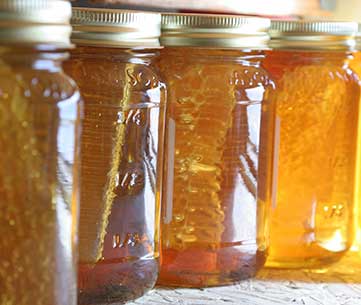

American foulbrood (AFB) is the most widespread and commercially significant bee disease that is currently present in Australia. A major factor in successful management of this disease is early detection. However, AFB can be difficult or even impossible to detect visually in the very early stages of inspection.
(AFB) is the most widespread and commercially significant bee disease that is currently present in Australia. A major factor in successful management of this disease is early detection. However, AFB can be difficult or even impossible to detect visually in the very early stages of inspection.
If AFB is present in a hive, then its spores will be present in the honey. Laboratory tests can confirm the presence of AFB spores in honey with very high confidence even if it is at very low levels. Annual honey tests will provide an important snapshot of the prevalence of AFB in different geographical areas, and monitoring changes in disease levels will allow some insight into the effectiveness of the Code and whether any modifications to it will be necessary in the future.
As such, beekeepers that manage 50 hives or more are required to submit a pooled honey sample collected from at least 20% of their hives to an independent laboratory. While this is not a Code requirement for smaller-scale beekeepers, it is nevertheless strongly recommended that all beekeepers regularly submit honey samples for AFB testing.
| REQUIREMENT 10.1 This section applies only to beekeepers who manage 50 or more hives. 10.2 A beekeeper must have their hives independently tested for the presence of American foulbrood at least once in every 12 consecutive months by: a) The microbiological examination of a representative, pooled honey sample by an approved laboratory, or 10.3 Where a beekeeper sends honey to a honey packer, the honey sample may be collected by the packer from submitted honey containers and consigned to an approved laboratory. |
Collect 100g of honey in a secure jar. The honey sample should be collected after extraction and should not contain comb scrapings or other debris. If you use a barrier system, you should test a separate sample from each barrier unit so in the event of a positive result you know which unit is infected.
New South Wales
State Veterinary Diagnostic Laboratory
Officer-in-charge
Courier: Woodbridge Road, Menangle NSW 2568
Post: Private Mail Bag 4008, Narellan NSW 2567
Victoria
Gribbles Veterinary Pathology
Contact the help desk on vets@gribbles.com.au
Staff will arrange for a honey test kit to be sent to you with instructions for submissions. Samples can either be posted back in the supplied post pack or dropped off at one of the many Australian Clinical Labs Collection Centres. Please ask for your nearest collection centre when you email.
South Australia
Gribbles Pathology
Primary Industries and Regions SA
33 Flemington Street
Glenside SA 5065
Annual AFB Honey Test Submission Form
Tasmania
Animal Health Laboratory
In person: Animal Health Laboratory, 165 Westbury Rd, Prospect, Tasmania, 7250
By post: Animal Health Laboratory – Specimen Reception, PO Box 46, Kings Meadows, Tasmania, 7249
Honey or Brood comb submission form
Factsheet on how to complete the submission forms
Western Australia
DDLS – Animal Pathology DPIRD
Locked Bag 4
Bentley Delivery Centre
Western Australia 6983
Queensland
Biosecurity Sciences Laboratory
Health and Food Science Precinct
PO Box 156
Archerfield BC Qld 4108
OR
Specimen Receipt (Loading Dock 12)
Biosecurity Sciences Laboratory
Health and Food Science Precinct
39 Kessels Road
Coopers Plains Qld 4108
Phone: (07) 3708 8762 (submission enquiries)
Submission form
Northern Territory
All suspect samples should be submitted to your regional Department of Primary Industry Resources (DPIR) office for a laboratory diagnosis.
Positive results are usually expressed as +1, +2 or +3 with the scores representing the likelihood of visual symptoms of AFB appearing in the hives the honey was collected from. +1 indicates a 56% chance of observing AFB, +2 an 80% chance and +3 a 100% chance.
Note that while a negative result will provide a good indication that there are no AFB spores present in the hives the honey came from, it cannot say this with certainty. Regular brood inspections for signs of AFB should always be a part of your beekeeping practice.
If the sample you had tested was pooled from several hives and tests positive, you will not know which specific hive or hives from that group is infected. You will then need to go and inspect all of the hives that contributed honey to the sample for symptoms of AFB. When you have identified the infected hives, follow the procedures outlined in Section 4.
Managing AFB: Guidelines for the identification and management of American foulbrood – a fatal disease of honey bee colonies (NSW Department of Primary Industries)
Australian Honey Bee Industry Biosecurity Code of Practice
The Code of Practice is also available in Greek, Arabic, Italian and Turkish
The following record keeping templates for honey production were created for B-Qual, an industry owned quality assurance program.